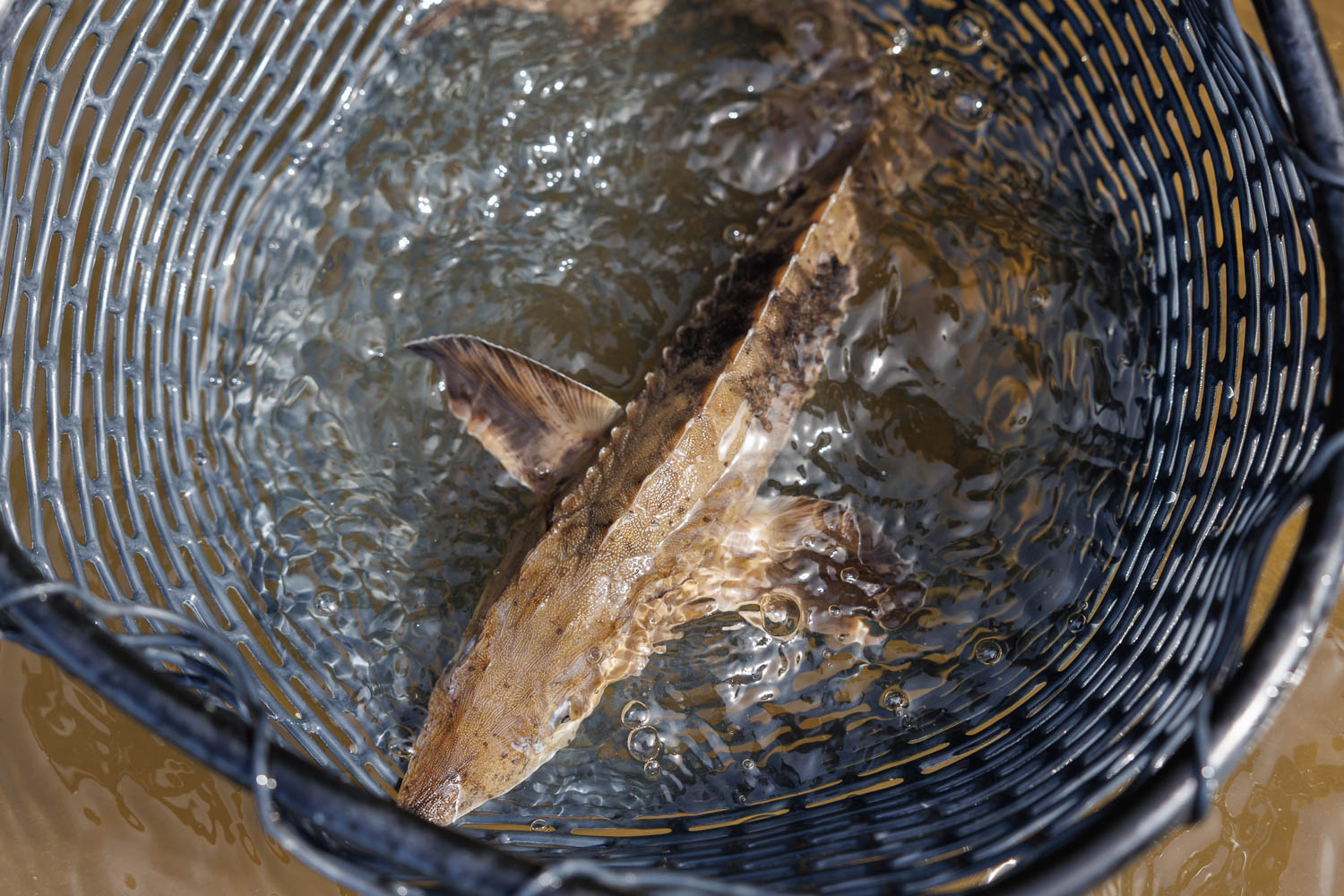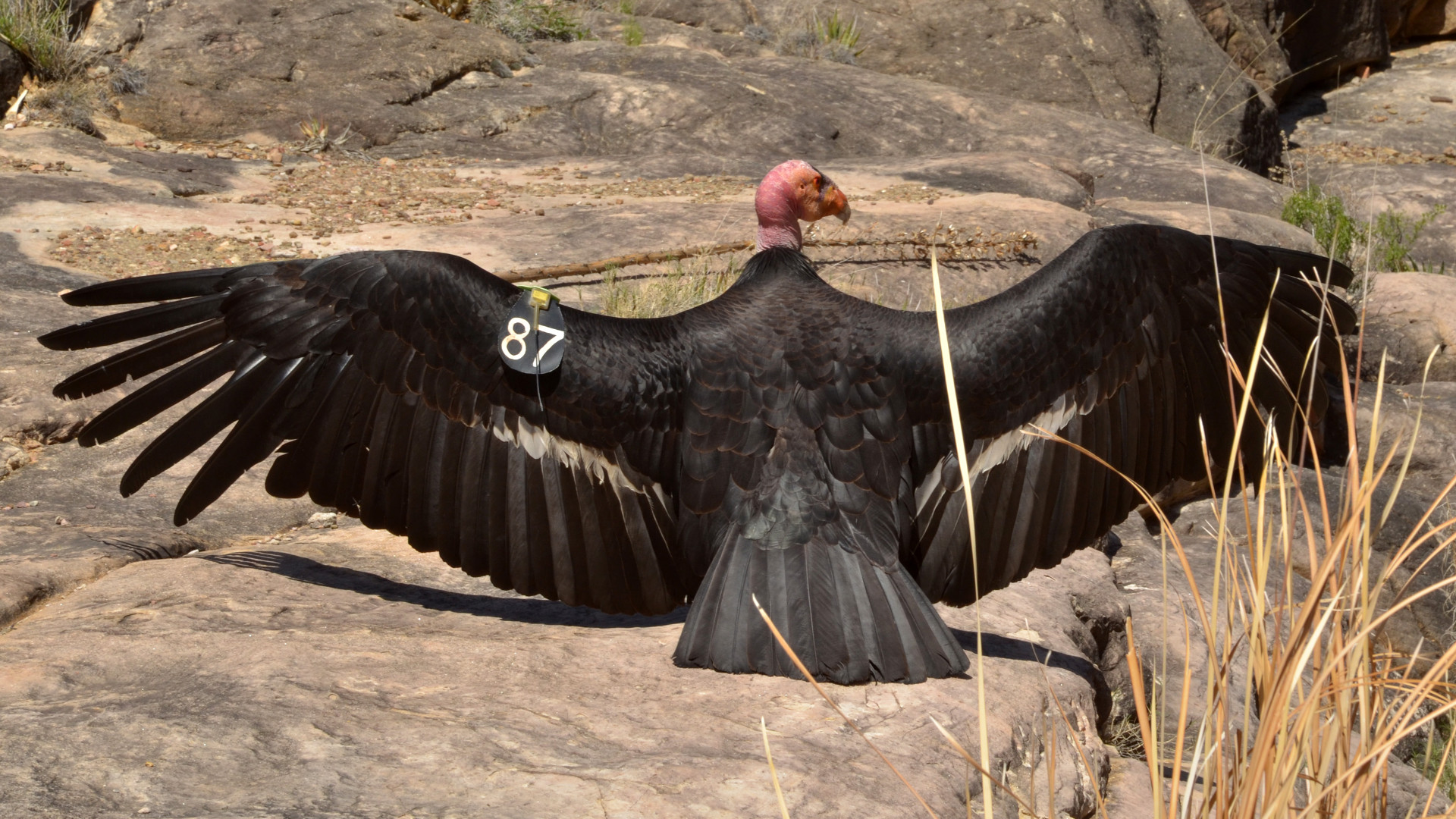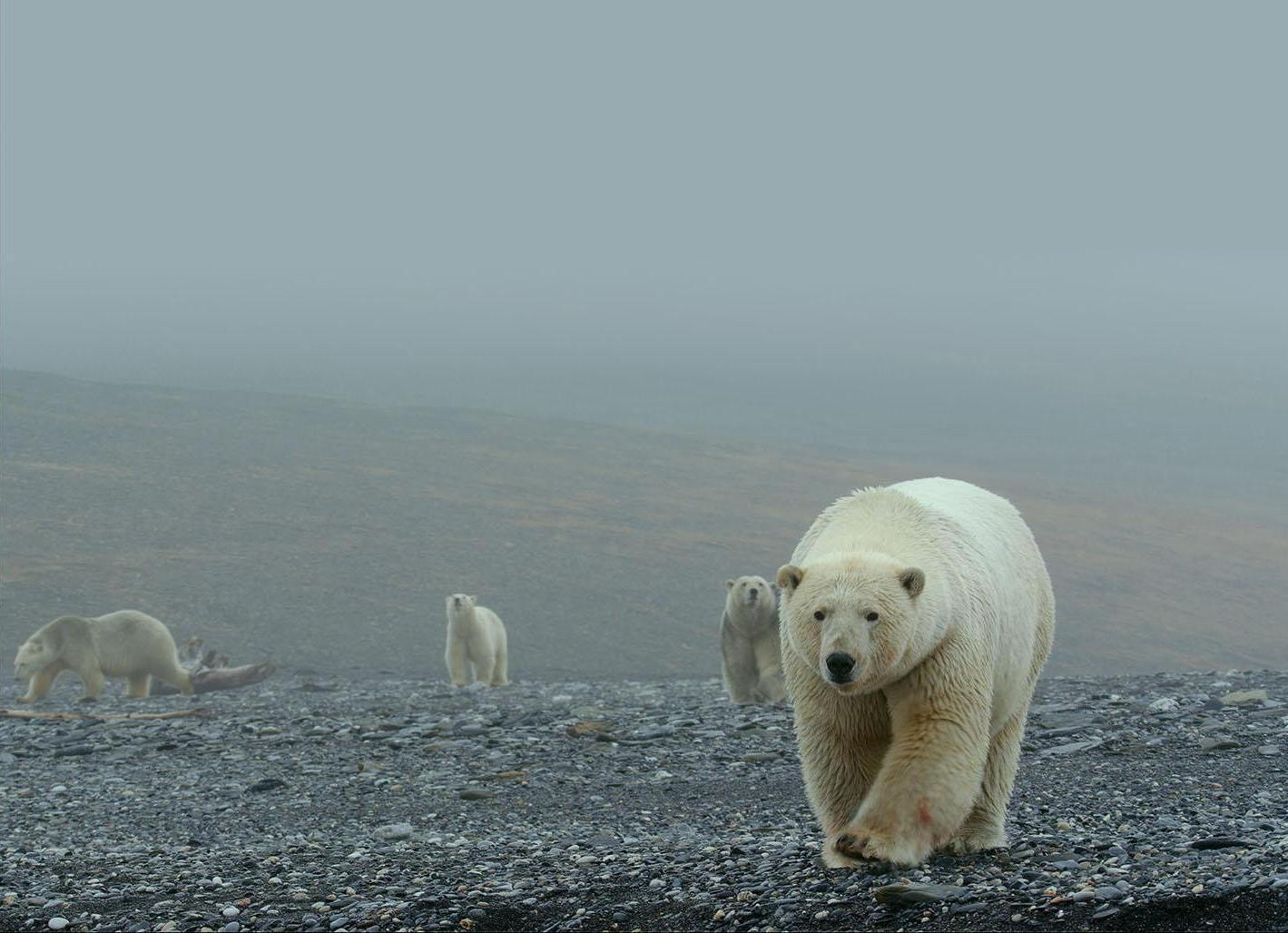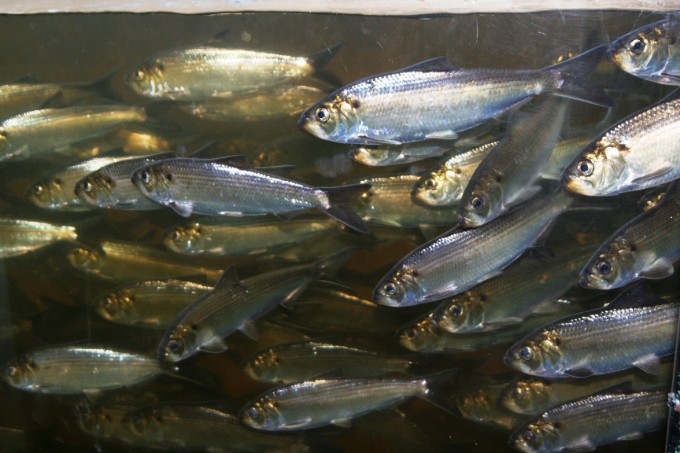
14 Life Below Water (83)
Conserve and sustainably use the oceans, seas and marine resources for sustainable development
Baby sturgeon hit the river in latest phase of 25-year restoration effort
Written by Doug Strickland This juvenile lake sturgeon was one of 50 released into the Tennessee River from Chattanooga’s Coolidge Park on May 2. The lineage of the fish can be traced millions of years, but overfishing, dams and habitat destruction has led to widespread population declines throughout its natural range. Doug Strickland/Tennessee Aquarium
This juvenile lake sturgeon was one of 50 released into the Tennessee River from Chattanooga’s Coolidge Park on May 2. The lineage of the fish can be traced millions of years, but overfishing, dams and habitat destruction has led to widespread population declines throughout its natural range. Doug Strickland/Tennessee Aquarium
Lake sturgeon recovery links rivers and experts in Tennessee and Wisconsin
Doug Strickland is a writer for the Tennessee Aquarium in Chattanooga.
CHATTANOOGA — Just across from the iconic peaks of the Tennessee Aquarium on the shore of the Tennessee River, a group of scientists with the Tennessee Aquarium Conservation Institute gathered on an early May morning to restore a primordial fish to the state’s primary waterway.
One by one, they carefully navigated down a boat ramp at Coolidge Park before gently releasing juvenile lake sturgeon, each just under a foot in length, into the river’s shallows.
These 50 sturgeon were the final youngsters to be reintroduced from a class of hundreds of sturgeon fry that arrived at the Conservation Institute’s freshwater field station last summer. Their introduction to the Tennessee River represented the latest milestone of a decades-long conservation effort to restore this state-endangered fish.
Despite reclaiming their one-time home in the waters of the Volunteer State, these newfound Tennesseans began life some 850 miles north of Chattanooga.
- lake strugeon release
- lake sturgeon working group
- lake sturgeon
- sturgeon in tennessee river
- sturgeon reintroduction
- sturgeon guard
- cumberland river sturgeon
- wolf river in wisconsin
- showano, wisconsin
- coolidge park chattanooga
- tennessee aquarium conservation institute
- tennessee aquarium
- sarah kate bailey
- warm springs national fish hatchery
- margaret stadig
- clean water act of 1972
- helaina gomez tennessee aquarium
- are there sturgeon in tennessee river?
- sturgeon spawning
- doug strickland
Tennessee’s mighty Duck River is gravely imperiled
Written by Anita Wadhwani A view of the Duck River, Tennessee longest river, from Old Stone Fort in Manchester. John Partipilo/Tennessee Lookout
A view of the Duck River, Tennessee longest river, from Old Stone Fort in Manchester. John Partipilo/Tennessee Lookout
The Duck landed third on American Rivers’ list of most endangered rivers in the U.S.
This story was originally published by Tennessee Lookout.
COLUMBIA — The Duck River, which winds through seven Middle Tennessee counties for more than 260 miles before reaching the Tennessee River, is among the most endangered rivers in the United States, according to a new report by the advocacy group American Rivers.
Threatened by population growth, development and climate change “urgent action is needed to safeguard this vital ecosystem,” the report released Tuesday said.
The Duck River serves as the source of drinking water for nearly 250,000 Tennesseans. Industry and agriculture depend on it, too. Often considered one of Tennessee’s most pristine waterways, it draws more than 150,000 people each year for boating, fishing and other recreation. Last year, in an effort to protect the river from a controversial plan to establish a landfill near its banks, state lawmakers designated a portion of the river in Maury County an official state scenic waterway.
Want to help wildlife? TWRA to host huge habitat-improvement event

Observe, upload and preserve during the City Nature Challenge
Written by Thomas Fraser
KNOXVILLE — People across 13 counties in East Tennessee are urged to record animals, plants and fungi they observe for four days in late April.
City Nature Challenge 2024 is international, but the Knoxville-area challenge includes anyone in Anderson, Blount, Campbell, Claiborne, Grainger, Jefferson, Knox, Loudon, Morgan, Roane, Scott, Sevier and Union counties. It will run April 26 through April 29 via the iNaturalist app, which is available on Google play or the App Store. While the focus is largely centered on urban areas, participants don’t have to live within a city or town to record their observations.
Participants can upload photos from a digital camera to the iNaturalist website even if they lack a smartphone. Zoo Knoxville, Tennessee Butterfly Monitoring Challenge, the city of Knoxville, Ijams Nature Center, Sierra Club, South Doyle Middle School and Discover Life in America are partnering to support the project. No experience is needed to participate. Results will be announced on May 6.
From Lil Jefe to hellbenders, wild animals inspired hope and validation for the conservation of the world in 2023
Written by Tim Lydon In September, six California condors repeatedly ventured north from their Pinnacles National Park homeland to Mount Diablo in the San Francisco Bay area, becoming the first condors seen in that area in over a century. Biologists speculate the sorties may indicate new nesting territories. Seen here is a condor deemed California condor 87 by biologists tracking the rare bird population. Michael Quinn/National Park Service
In September, six California condors repeatedly ventured north from their Pinnacles National Park homeland to Mount Diablo in the San Francisco Bay area, becoming the first condors seen in that area in over a century. Biologists speculate the sorties may indicate new nesting territories. Seen here is a condor deemed California condor 87 by biologists tracking the rare bird population. Michael Quinn/National Park Service
Rare and threatened animals used innate skills and courage to recover lost territory, expand their ranges, or simply survive against the odds. Humans helped.
It’s tradition to honor the past year’s human achievements. From peacemakers and scientists to athletes and artists, we celebrate those who inspire us. But what about the wildlife who surround us who make up the biodiversity that sustains us? Each year standout members of those populations also set records and push boundaries, many with lasting results.
Consider P-22, also known as the “Hollywood cat.” In 2012 this young mountain lion surprised biologists and captured hearts by establishing a decade-long residency in the Griffith Park area of Los Angeles. Stealthily threading through backyards and freeways, he demonstrated the value of landscape connectivity, even in urban areas. And though he died in 2022, he inspired a massive fundraising campaign that helped build the largest wildlife bridge in the United States, to be completed in 2025 over California’s 10-lane Highway 101. In this way he changed the world.
- wildlife conservation
- ozark hellbender
- california condor
- tim lydon
- the revelator
- prince william sound stewardship foundation
- hollywood cat
- mountain lions
- ocelots
- grizzlies on the great plains
- endangered species act
- missouri river breaks
- wolverines endangered species act
- american prairie
- wolves in southern sierras
- flamingos
- hurricane flamingoes
- huachuca mountains
- saint louis zoo
- okaloosa darter
RESCHEDULED: Mudchasers wanted: Sign up to track pollution and sediment pumps

KNOXVILLE — Join Chris Irwin and others to learn how to help track the origin of sediments and other pollutants in area waterways.
The meeting was postponed by snow and is now set for 7 p.m. Jan. 24 at Barleys, 200 East Jackson Ave., Knoxville.
“Spring is coming and with it rain and mud into the creeks and streams around Knoxville. We think a handful of people working together can stop a lot of mud going into the Tennessee River.
Visit the Arctic at Tennessee Aquarium in Chattanooga. While you still can.
Written by Doug Strickland Polar bears on Wrangel Island, Russia. As the sea ice melts each summer, more than 1,000 bears come to Wrangel to wait for the return of the sea ice. It's the largest concentration of polar bears on Earth. BBC Studios via Tennessee Aquarium
Polar bears on Wrangel Island, Russia. As the sea ice melts each summer, more than 1,000 bears come to Wrangel to wait for the return of the sea ice. It's the largest concentration of polar bears on Earth. BBC Studios via Tennessee Aquarium
Learn how the Arctic still thrives in the face of existential climate threats in new IMAX film
Doug Strickland is a writer for the Tennessee Aquarium.
CHATTANOOGA — At first glance, the Arctic seems an impossibly inhospitable place, a frigid wasteland of extremes in which nothing can survive.
Only one-quarter of this vast polar region at the top of the world is made up of land. The rest is comprised of a glacially cold ocean capped by vast stretches of ice.
Despite its harsh conditions, life has found a way to endure — and even thrive — in the Arctic. Audiences will meet just a few of the Arctic’s charismatic residents on Jan. 11, 2024 when the Tennessee Aquarium IMAX 3D Theater debuts a new giant-screen film, Arctic 3D: Our Frozen Planet.
Fish are featured this month at Conservation on Tap
 Barrens topminnow (Fundulus julisia) at Conservation Fisheries, a native stream fish breeding center. This species is endangered (IUCN). It is only found in the Barrens Plateau in Middle Tennessee, making it one of the rarest fish in eastern North America. © Joel Sartore 2023
Barrens topminnow (Fundulus julisia) at Conservation Fisheries, a native stream fish breeding center. This species is endangered (IUCN). It is only found in the Barrens Plateau in Middle Tennessee, making it one of the rarest fish in eastern North America. © Joel Sartore 2023
KNOXVILLE — The next round of Conservation on Tap features Conservation Fisheries and its efforts to restore and conserve some of the most diverse fish populations on the planet.
It’s set for 7 p.m. Jan. 10 at Albright Grove Brewing Company, 2924 Sutherland Ave. Proceeds from the event benefit Discover Life in America, a crucial science partner with Great Smoky Mountains National Park.
“Did you know the incredibly diverse Tennessee River harbors over 225 species of fish, including more than 50 species at risk of extinction? Come join staff from Knoxville nonprofit Conservation Fisheries Inc. to learn about CFI's mission to prevent the extinction of rare fish species, and to work for their long-term recovery. We will be discussing some of our successes in fish recovery efforts over the past 37 years, including species found in Great Smoky Mountains National Park.”
TWRA fisheries and crayfish expert retires after four decades of service
Written by Tennessee Wildlife Resources Agency Carl Williams, a TWRA fisheries technician and self-taught crayfish biologist. TWRA
Carl Williams, a TWRA fisheries technician and self-taught crayfish biologist. TWRA
MORRISTOWN — Carl Williams, a Tennessee Wildlife Resources Agency fisheries technician and self-taught crayfish biologist retired after dedicating more than four decades to wildlife and fisheries conservation and management.
Williams began working with TWRA in August 1979 through the Young Adult Conservation Corp (YACC), which was a federally funded program. Initially hired for a one-year assignment, he worked with lands management wildlife biologists on various projects, including white-tailed deer and wild turkey restoration.
The subsequent year marked a shift as he joined TWRA’s Fisheries Division, conducting creel surveys on Cherokee and Douglas reservoirs. In August 1981, he transitioned to the Buffalo Springs Trout Hatchery spending the next seven years propagating and rearing rainbow, brown, brook, lake and Ohrid trout, and distributing them throughout many streams, rivers and reservoirs in East Tennessee.
The Revelator: 10 ways targeted dam removals can help solve the climate change dilemma
Written by Gary Wockner Alewives returned by the millions after the Edwards and Ft. Halifax dams were removed in Maine. John Burrows/ASF via The Revelator
Alewives returned by the millions after the Edwards and Ft. Halifax dams were removed in Maine. John Burrows/ASF via The Revelator
By providing both mitigation and adaption, dam removal can lower greenhouse gas emissions and restore carbon sinks.
This article was originally published in The Revelator. Gary Wockner
As the climate crisis escalates, a huge amount of attention and money is being focused on climate solutions.
These can be divided into two categories: solutions that pursue “mitigation,” which lowers greenhouse gas emissions, and those that pursue methods to adapt to climate impacts to increase human and ecological resiliency.
Dams, of course, create enormous environmental harms, many of which have already been described in scientific literature. Equally well documented is the fact that removing dams can restore seriously damaged ecosystems. But missing from almost every climate-solution story and study is how dam removal can be key for both mitigation and adaptation.
Here are 10 reasons how dam removal fights climate change.
- climate action
- dam removal
- the revelator
- gary wockner
- greenhouse gas emission
- methane emission
- natural flow of the river
- river plume
- carbon sink
- reservoir
- biodiversity
- sediment transport
- fish population dynamic
- water supply
- reservoir evaporation
- climate resilience
- heat island
- forest cooling effect
- river cooling effect
- climate crisis
- lake mead water level
- colorado river water restriction
More...
Meet the salamanders making the South a biodiversity hotspot
Written by Southern Environmental Law CenterSkip to main co An eastern newt in its juvenile stage in Blacksburg, Virginia. Courtesy SELC.
An eastern newt in its juvenile stage in Blacksburg, Virginia. Courtesy SELC.
Salamanders are under siege in a changing world
Salamanders are extraordinary creatures. Some of these astonishing amphibians boast vibrant colors and patterns while two-thirds of all species are lungless and able to breathe through their skin. All salamanders have the remarkable ability to regrow limbs, tails, and even parts of their heart and brain, a rare ability in the animal kingdom.
More salamander species live in the Appalachians than anywhere else in the world. Fifty-four species of salamander call Virginia home.
Roughly 20 percent of the world’s salamander species can be found in the South
Unfortunately, the impacts of climate change, habitat loss and pollution pose a real danger to these sensitive creatures. Increased temperatures, changing humidity levels, wildfires and droughts wreak havoc on salamanders, which are impacted by even small changes in habitat conditions and are often specialized to small native ranges.
Southern Environmental Law Center’s work addressing climate change, fighting for clean water, and conservation efforts help protect all kinds of salamanders in the South. To celebrate the Endangered Species Act’s 50th anniversary, they are highlighting some of the endangered and threatened salamanders of our region.
 Representatives from U.S. Fish and Wildlife Service and the Tennessee Aquarium Conservation Institute work together to rescue Barrens Topminnows imperiled by an exceptional drought in Nov. 2016. Tennessee Aquarium
Representatives from U.S. Fish and Wildlife Service and the Tennessee Aquarium Conservation Institute work together to rescue Barrens Topminnows imperiled by an exceptional drought in Nov. 2016. Tennessee Aquarium
Drought conditions threaten some of the nation’s most-endangered fish species
Casey Phillips is a communications specialist at the Tennessee Aquarium in Chattanooga.
CHATTANOOGA — The endless parade of sunny, cloudless days in Chattanooga for the last two months may seem like the stuff of dreams to anyone planning an outdoor activity. However, this fall has turned into a blue-sky nightmare for aquatic species living in smaller creeks and streams.
“Some of those headwater pools are going to dry up, and we’ll lose large numbers of populations,” said Dr. Bernie Kuhajda, an aquatic conservation biologist at the Tennessee Aquarium Conservation Institute. “It just doesn’t look good for our headwater fish communities out there. They’re really getting stressed.”
Less than half an inch (0.42 inches) of rain fell in Chattanooga during a 72-day span between Aug. 30 and Nov. 9, according to meteorological data recorded at Lovell Field. That’s just 0.16 inches more than fell in Death Valley, California, during the same period, according to the National Oceanic and Atmospheric Administration (NOAA).
As of the latest weekly report by the government’s U.S. Drought Monitor, most of Hamilton County is now considered to be experiencing a D4 or “exceptional” drought, the Monitor’s most severe drought category.
Bad news for endangered fish species like the Barrens Topminnow and Laurel Dace.
Ela dam removal proceeds to make a river run through
Written by Erin Singer McCombs Ela Dam on the Oconaluftee River in Cherokee. The dam is slated for removal to benefit aquatic species and the Eastern Band of the Cherokee Indians. Erin McCombs
Ela Dam on the Oconaluftee River in Cherokee. The dam is slated for removal to benefit aquatic species and the Eastern Band of the Cherokee Indians. Erin McCombs
Ela Dam Removal Coalition moving forward after $4 million grant from U.S. Fish and Wildlife to commence river restoration project
Erin McCombs is the Southeast Conservation Director of American Rivers.
CHEROKEE — American Rivers is working with a team on a massive effort to remove the Ela dam and restore the land and Oconaluftee River to its natural condition. Partnering with the Eastern Band of Cherokee Indians (EBCI), American Rivers is part of a coalition of federal, state, public, private, and non-profit organizations that has formed to remove the Ela dam.
Truly a village effort, the Ela Dam Coalition includes the EBCI, American Rivers, Mainspring Conservation Trust, the North Carolina Wildlife Resources Commission, the U.S. Fish and Wildlife Service, the Southern Environmental Law Center, the Environmental Protection Agency, American Whitewater, Swain County, the Army Corps of Engineers, and Northbrook Carolina Hydro II.
“Healthy rivers are essential to all life, and removing a dam is the fastest way to restore a river’s health. We appreciate this initial investment by U.S. Fish and Wildlife Service in the restoration of the Oconaluftee River. We look forward to working with them to leverage this investment to fully realize this project to revitalize fish and wildlife habitat and restore vital cultural connections. We are grateful to the Eastern Band of Cherokee Indians for their leadership, and for the partnership of Mainspring Conservation Trust,” said Tom Kiernan, American Rivers President and CEO.
Blocking the Oconaluftee River’s natural flow impacts the aquatic habitats of many native fish, mussels, birds, and other wildlife which require it for sheltering, feeding, reproducing, and thriving in their natural environment. The removal of Ela dam will result in a cultural reconnection of the Oconaluftee River to the Cherokee people and the Qualla Boundary.
The Oconaluftee River is home to 11 sensitive and rare aquatic species, some of which are only found in a few streams and rivers in western North Carolina, including the federally endangered Appalachian elktoe freshwater mussel, the Sicklefin Redhorse (NC Threatened), and Eastern Hellbender (NC Special Concern). Once complete, 549 miles of the Oconaluftee River watershed will be restored and expand habitat for these species.
- american rivers
- ela dam
- eastern band of cherokee indians
- ela dam coalition
- mainspring conservation trust
- north carolina wildlife resources commission
- us fish and wildlife service
- southern environmental law center
- oconaluftee river
- joey owle
- environmental protection agency
- american whitewater
- swain county
- army corps of engineers
- northbrook carolina hydro ii
- bryson city
- sicklefin redhorse
- eastern hellbender
- appalachian elktoe
Great fish caught on Watts Bar Reservoir
Rhea County — Watts Bar Reservoir created in 1942, has remained a consistent bass fishery according to data collected over the past decades. Reservoir biologists are hopeful that a recent catch is reflective of Florida largemouth bass stocking efforts started in 2015.
Randy Miller of Spring City caught an 11.22-pound largemouth bass on the reservoir and graciously shared the photo with reservoir biologist Mike Jolley. Jolley, an employee with over three decades of professional experience, grew up on the lake and has intimate knowledge of its waters. Jolley shared, “We routinely evaluate our fisheries in reservoirs, including Watts Bar, to assess overall health of population dynamics. Some anglers have questioned the status of the bass fishery in this lake. I’m happy to share that Watts Bar has remained a consistent fishery based on long-term, routine data collection.”
